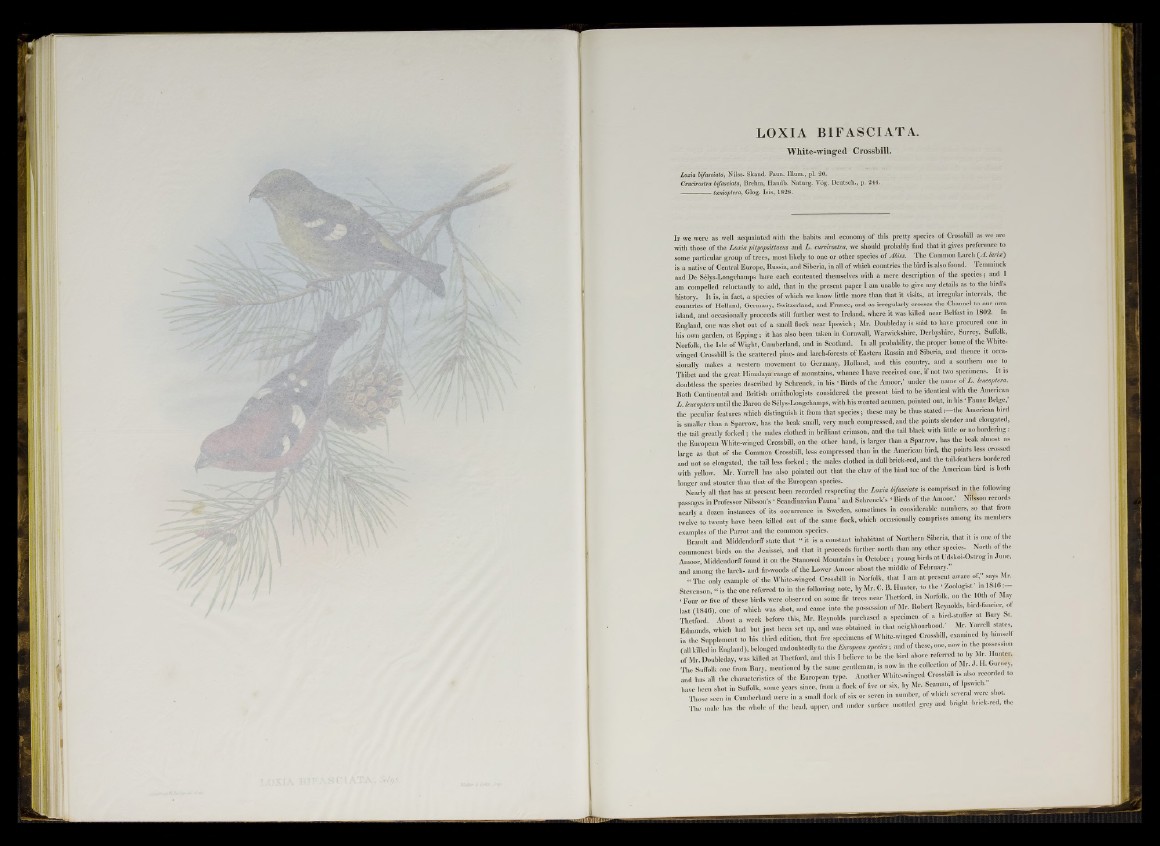
LOXIA B1FASCIATA.
White-wing-ed Crossbill.
Loxia bifasciata, Nilss. Skand. Faun. Ilium., pi. 20.
Crucirostra bifasciata, Brehm, Handb. Naturg. Vog. Deutsch., p. 244.
----------:— tatnioptera, Glog. Isis, 1828.
If we were as well acquainted with the habits and economy of this pretty species of Crossbill as we are
with those of the Loxia pilyopsittacus and L. curvirostra, we should probably find that it gives preference to
some particular group of trees, most likely to one or other species of Abies. The Common Larch (A. larix)
is a native of Central Europe, Russia, and Siberia, in all of which countries the bird is also found. Temminck
and De Selys-Longchamps have each contented themselves with a mere description of the species; and I
am compelled reluctantly to add, that in the present paper I am unable to give any details as to the bird’s
history. It is, in fact, a species of which we know little more than that it visits, at irregular intervals, the
countries of Holland, Germany, Switzerland, and France, and as irregularly crosses the Channel to onr own
island, and occasionally proceeds still further west to Ireland, where it was killed near Belfast in 1802. In
England, one was shot out of a small flock near Ipswich; Mr. Doubleday is said to have procured one in
his own garden, at Epping; it has also been taken in Cornwall, Warwickshire, Derbyshire, Surrey, Suffolk,
Norfolk, the Isle of Wight, Cumberland, and in Scotland. In all probability, the proper home of the White-
winged Crossbill is the scattered pine- and larch-forests of Eastern Russia and Siberia, and thence it occasionally
makes a westeru movement to Germany, Holland, and this country, and a southern one to
Thibet and the great Himalaya-range of mountains, whence I have received one, if not two specimens. It is
doubtless the species described by Schrenck, in his ‘ Birds of the Amoor,’ under the name of L. leacoptera.
Both Continental and British ornithologists considered the present bird to be identical with the American
L. leacoptera until the Baron de Selys-Longchamps, with his wonted acumen, pointed out, in his ‘ Faune Beige,
the peculiar features which distinguish it from that species; these may he thus s t at edt he American bird
is smaller than a Sparrow, has the beak small, very much compressed, and the points slender and elongated,
the tail greatly forked 5 the males clothed in brilliant crimson, and the tail black with little or no bordering:
the European White-winged Crossbill, on the other hand, is larger than a Sparrow, has the beak almost as
large as that of the Common Crossbill, less compressed than in the American bird, the points less crossed
and not so elongated, the tail less forked; the males clothed in dull brick-red, and the tail-feathers bordered
with yellow. Mr. Yarrell has also pointed out that the claw of the hind toe of the American bird is both
longer and stouter than that of the European species.
Nearly all that has at present been recorded respecting the Loxia bifasciata is comprised in the following
passages in Professor Nilsson’s ‘ Scandinavian Fauna ’ and Sclirenck's ‘ Birds of the Amoor.’ Nilsson records
nearly a dozen instances of its occurrence in Sweden, sometimes in considerable numbers, so that from
twelve to twenty have been killed out of the same flock, which occasionally comprises among its members
examples of the Parrot and the common species.
Brandt and Middendorff state that “ it is a constant inhabitant of Northern Siberia, that it is one of the
commonest birds on the Jenissei, and that it proceeds further north than any other species. North of the
Amoor, Middendorff found it on the Stanowoi Mountains in October; young birds at Udskoi-Ostrog m June,
and among the larch- and fir-woods of the Lower Amoor about the middle of February.
The only example of the White-winged Crossbill in Norfolk, that I am at present aware of, says Mr.
Stevenson, | is the one referred to in the following note, by Mr. C. B. Hunter, to the ! Zoologist ’ in 18 :
• Four or five of these birds were observed on some fir trees near Thetford, in Norfolk, on the 10th of May
last (1846), one of which was shot, and came into the possession of Mr. Robert Reynolds, bird-fancier, of
Thetford. About a week before this, Mr. Reynolds purchased a specimen of a bird-stuffer at Bury St.
Edmunds, which had hut just been set op, and was obtained in that neighbourhood. Mr. arre slates,
in the Supplement to his third edition, that five specimens of White-winged Crossbill, examined by himself
(all killed in England), belonged undoubtedly to the European species; and of these, one, now in the possession
of Mr. Douhleday, was killed at Thetford, and this I believe to be the bird above referred to by Mr. Hunter.
The Suffolk one from Bury, mentioned by the same gentleman, is now in the collection of Mr. J. H. Gurney,
I all the characteristics of the European type. Another White-winged Crossbill ,s also recorded to
and has
have been shot in Suffolk, some years since, from 1 a i. flock of five or six, by .
Mr. Seaman, of Ipswich.”
Those seen in Cumberland were in a small flock of six or seven in number, of winch several were shot
nd under surface mottled grey The male has the whole of the head, upper, and and bright brick-red, the